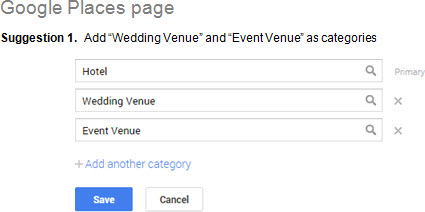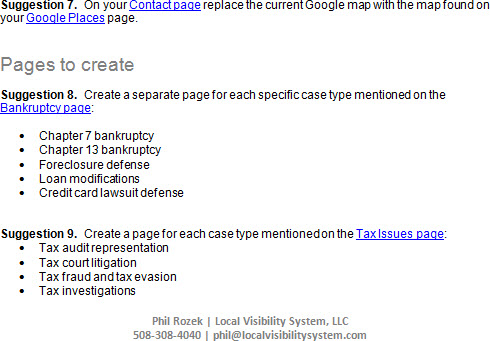
If you aren’t sure what a local SEO audit is and have no idea how to do one, you’ve come to the wrong place. (In that case, start with Casey Meraz’s monster post.)
But I’m guessing your problem is that your local SEO audits don’t go boom.
To be more specific, I’d wager that you’ve got at least one of these concerns:
- Clients don’t seem to understand your audits
- Clients don’t act on your audits
- You feel overwhelmed by your own audits
- You want to eliminate wastes of time and effort
- You want to make your audits better
If any of the above describes you, grab a match and some earplugs and come with me.
Below are my 20 principles for a dynamite local SEO audit.
(By the way, you don’t have to be a professional SEO geek to benefit. These rules will help you create your own plan – and act on it – if you’re a business owner.)
Cardinal Rule
1. Make it easy to act on.
If your client can’t easily act on at least some of your suggestions right away, you’ve failed. Keep explanation to a minimum and focus on the “do this.” (Several of the other 19 principles deal with how to make your audit actionable.)

For me, the trick is to keep simple suggestions brief. That way, clients aren’t worn out by the time they get to the more-involved steps that require me to lay out a bunch of baby steps.
Before you start
2. Get the facts from your client.
At the very least, ask your client to fill out your version of my standard questionnaire.
Then, unless they’re do-the-bare-minimum types, also ask them to fill out any additional questionnaires you might have – like the one I use for link-research.
3. Know your client’s level of technical know-how.
Err on the side of not using jargon. To the extent you must use it, try to explain it briefly.

4. Ask your client about any suspected (or confirmed) penalties from Google.
If your client seems to have no clue, ask whether there have been any noticeable drops in rankings or traffic.
You need to know as much history as possible. By the way, I’m mostly referring to link-based penalties – although there are many other explanations for a hard thud.

5. Get all the relevant login info, if possible.
If possible, do a behind-the-scenes checkup before spending too much time on the audit. What you find in there might change your suggestions (see principle #4).
By the way, the areas I suggest you get access to include Google Places, Analytics, Webmaster Tools, and Yext (if the client uses Yext).
The audit (your comprehensive check-up)
6. Know your priorities:
Priority 1: Address any specific problems the client mentioned. (Example: “Here’s what to do about your 3 duplicate Google Places pages….”)
Priority 2: Uncover and address problems the client seems not to know about. (Example: “Your robots.txt file is blocking your entire site.”)
Priority 3: Easy big wins. (Example: “Half your citations don’t have your URL in the ‘Website’ field.”)
Priority 4: Difficult-but-crucial wins. (Example: “Here’s how I suggest you earn 3 links you really need to earn….”)
Priority 5: All other problems and suggestions.
7. Don’t rely on tools.
By that I mean two things:
(1) It’s fine to use – for example – Screaming Frog as a starting point for crawling through the website, and Moz Local as a starting point for auditing the citations, but then you need to dig deeper.
(2) The results of that deep dig are what should go in your report – NOT simply a screenshot of what the free scan dug up. (The only exception I make is when I find lots of broken links, in which case I reference the results of a tool like brokenlinkcheck.com.)
8. The citations audit should be in a separate document – a spreadsheet.
It needs to be easy for your client to understand and to act on your citation recommendations.
Here’s an example of what I send clients. (Usually I also include 5-10 listings specific to the client, like industry citations.)
I also suggest you don’t audit more than 40-50 sites, tops. You hit a point of diminishing return – fast. Your client’s rankings aren’t moving up or down because of little sites that nobody (besides SEOs) has heard of. Keep moving along.
9. Don’t ignore user-experience issues.
They might indirectly hurt rankings – or simply scare off visitors.
Autoplay videos will send many a visitor scrambling for the “back” button. Hard-to-use navigation, hard-to-find internal links, or thin content will keep visitors from going deeper into your site.
Keyword-stuffed description tags or a lack of review-diversity may keep people from clicking through to your site to begin with.
As I’ve said, Google knows everything about how users interact with your business – in the search results and on your site and everywhere else – and Google will judge you on it.
The report (what the client sees)
10. Write in plain English.
(Or whatever language you and your client speak.)
Your write-up needs to be conversational. Sounding like a robot or a professor won’t help your client take action.
11. Break the write-up into sections.
Group your suggestions. Here’s how I usually divide up my reports:
- Google Places page
- Website: general / site-wide (e.g. “Add NAP info”)
- Homepage
- Other pages
- Pages to create (e.g. these)
- Link opportunities
- Review strategy
- Citation audit (separate document)
12. Number your suggestions.
Numbers make the report more digestible, and you can more easily say things like, “Before you can do this step you’ll have to do suggestion #6.”

13. Go heavy on screenshots.

14. Include clickable links, when appropriate.
This helps you comment on specific pages on the site, or to cite “further reading” (for clients who are interested).

15. Show specific examples.
Show real-life examples, or examples of what you’re asking your client to do.

16. Indicate if there’s something you don’t know (yet).
Misplaced confidence can create problems.

Ideally you have all the facts you need before you even start the audit (see principle #2). If you don’t, it’s smart to ask your client any questions that come up while you’re working on the audit.
But short of doing that, you should at least say things like, “Based on my current understanding, I’d say you should do such-and-such. The only reason you might not want to take this suggestion is yada yada….”
17. Invite questions and requests.
Leave the door open. Say things like “Please let me know if you’d like even more link-earning ideas, once you’ve those 8 suggestions.”
18. Keep it snappy.
Abraham Lincoln once was asked, “Mr. Lincoln, how long do you think a man’s legs should be?” He replied, “Long enough to reach the ground.”
Better to give 8 pages of action items than to give 8 pages of action items and 3 pages of fluff. (My reports are usually around 10 pages, give or take a couple of pages.)
Business owners want clear solutions and suggestions, they want them fast, and then they want to get on with life.
After the audit
19. Offer some follow-up support.
I offer a wrap-up call in case clients want it at any point. It’s part of my service.
20. Find out which suggestions your client took.
A couple months after you’ve sent in the audit, either ask or just do a quick check. That’s your opportunity to offer to help if need be, and you can learn how to make future local SEO audits even better.
—
Any audit principles you’d add? How do you think you can improve your audits? Leave a comment!

That’s awesome Phil! I totally intend to use the information at my company. You are by far the most valuable resource The Bird Marketing has seen with regards to local SEO. We truly appreciate what you do 🙂
Thanks, Erick!
Phil
Are you in my head? These are EXACTLY the principles I follow when doing my audits. Of course they are mainly non-local SEO, but everything still applies!
Thanks, Dan! That’s great to hear: I know you do a mean SEO audit.
Thanks for only creating content that is useful Phil. Seriously, I really appreciate knowing that I’m that getting useful, original resources when I reat your new posts. Refreshing, like a cold beer on a hot Texas summer afternoon.
Hey Cody, thanks.
Phil – this is simply fantastic! And really cool to see the little empire of resources you’ve been building up internally that make some of these steps easier. An impressive piece!
Thanks a bunch, Miriam!
Fantastic writeup. What I do for points 1-4 is that I remove the business owner from my line of sight – I get access to all the systems myself so that I can view them as and when needed. Small business owners do not make you go through all the hoops of contracts and NDAs to just view their account info. Secondly, I ask for their developer and interact directly with them regarding implementation. In any case, the client is only going to forward back and forth the emails – so I keep them in the CC while interacting directly with the developer who knows what to do.
Crazy how after already 10 years, this local SEO audit is STILL in play and we follow these same principles at my company Pittsburgh SEO Magician to actually analyze local small business in our area. Thank you so much! 🙂